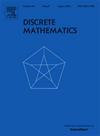欧拉图的路径分解
IF 0.7
3区 数学
Q2 MATHEMATICS
引用次数: 0
摘要
Gallai猜想断言,n个顶点上的每一个连通图都可以分解成n+12条路径。对于一般图(可能是不连通的),证明了n个顶点上的每个图都可以分解成2n3条路径。这也是最好的可能(考虑由顶点不相交的三角形组成的图)。Lovász证明了每个最多有一个偶数度顶点的n顶点图都可以分解成n2条路径。然而,对于具有许多偶数度顶点的图,Gallai的猜想是困难的。Favaron和Kouider对所有最大度不超过4的欧拉图验证了Gallai的猜想。在本文中,我们证明了如果G是一个有n≥4个顶点的欧拉图,并且G中任意两个三角形之间的距离至少为3,则G可以被分解为最多3n5条路径。本文章由计算机程序翻译,如有差异,请以英文原文为准。
Path decompositions of Eulerian graphs
Gallai's conjecture asserts that every connected graph on n vertices can be decomposed into paths. For general graphs (possibly disconnected), it was proved that every graph on n vertices can be decomposed into paths. This is also best possible (consider the graphs consisting of vertex-disjoint triangles). Lovász showed that every n-vertex graph with at most one vertex of even degree can be decomposed into paths. However, Gallai's conjecture is difficult for graphs with many vertices of even degrees. Favaron and Kouider verified Gallai's conjecture for all Eulerian graphs with maximum degree at most 4. In this paper, we show if G is an Eulerian graph on vertices and the distance between any two triangles in G is at least 3, then G can be decomposed into at most paths.
求助全文
通过发布文献求助,成功后即可免费获取论文全文。
去求助
来源期刊

Discrete Mathematics
数学-数学
CiteScore
1.50
自引率
12.50%
发文量
424
审稿时长
6 months
期刊介绍:
Discrete Mathematics provides a common forum for significant research in many areas of discrete mathematics and combinatorics. Among the fields covered by Discrete Mathematics are graph and hypergraph theory, enumeration, coding theory, block designs, the combinatorics of partially ordered sets, extremal set theory, matroid theory, algebraic combinatorics, discrete geometry, matrices, and discrete probability theory.
Items in the journal include research articles (Contributions or Notes, depending on length) and survey/expository articles (Perspectives). Efforts are made to process the submission of Notes (short articles) quickly. The Perspectives section features expository articles accessible to a broad audience that cast new light or present unifying points of view on well-known or insufficiently-known topics.
 求助内容:
求助内容: 应助结果提醒方式:
应助结果提醒方式:


